Events
| | This section needs expansion. You can help by adding to it. (July 2016) |
- The November Uprising (November Insurrection) [1]
- Battle of Khunzakh
- Cholera Riots
- Sevastopol plague uprising
| Years in Russia: | 1827 1828 1829 1830 1831 1832 1833 |
| Centuries: | 18th century · 19th century · 20th century |
| Decades: | 1800s 1810s 1820s 1830s 1840s 1850s 1860s |
| Years: | 1827 1828 1829 1830 1831 1832 1833 |
Events from the year 1830 in Russia
| | This section needs expansion. You can help by adding to it. (July 2016) |
| | This section needs expansion. You can help by adding to it. (July 2016) |
| | This section needs expansion. You can help by adding to it. (July 2016) |

Congress Poland, Congress Kingdom of Poland, or Russian Poland, formally known as the Kingdom of Poland, was a polity created in 1815 by the Congress of Vienna as a semi-autonomous Polish state, a successor to Napoleon's Duchy of Warsaw. It was established when the French ceded a part of Polish territory to the Russian Empire following France's defeat in the Napoleonic Wars. In 1915, during World War I, it was replaced by the German-controlled nominal Regency Kingdom until Poland regained independence in 1918.

The January Uprising was an insurrection principally in Russia's Kingdom of Poland that was aimed at putting an end to Russian occupation of part of Poland and regaining independence. It began on 22 January 1863 and continued until the last insurgents were captured by the Russian forces in 1864.

Hans Karl Friedrich Anton Graf von Diebitsch und Narten was a German-born soldier serving as Russian field marshal.
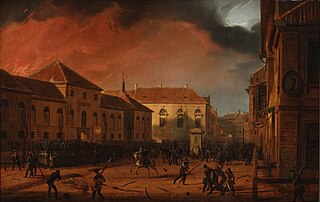
The November Uprising (1830–31), also known as the Polish–Russian War 1830–31 or the Cadet Revolution, was an armed rebellion in the heartland of partitioned Poland against the Russian Empire. The uprising began on 29 November 1830 in Warsaw when young Polish officers from the military academy of the Army of Congress Poland revolted, led by Lieutenant Piotr Wysocki. Large segments of the peoples of Lithuania, Belarus, and Right-bank Ukraine soon joined the uprising. Although the insurgents achieved local successes, a numerically superior Imperial Russian Army under Ivan Paskevich eventually crushed the uprising. The Russian Emperor Nicholas I issued the Organic Statute in 1832, according to which henceforth Russian-occupied Poland would lose its autonomy and become an integral part of the Russian Empire. Warsaw became little more than a military garrison, and its university closed.

Margrave Aleksander Ignacy Jan-Kanty Wielopolski was a Polish aristocrat, owner of large estates, and the 13th lord of the manor of Pinczów. In 1862 he was appointed head of Poland's Civil Administration within the Russian Empire under Tsar Alexander II.

The Autumn Harvest Uprising was an insurrection that took place in Hunan and Jiangxi provinces of China, on September 7, 1927, led by Mao Zedong, who established a short-lived Hunan Soviet.

Count Ivan Fyodorovich Paskevich-Erevansky, Serene Prince of Warsaw was an Imperial Russian military leader of Ukrainian Cossack origin who was the Namiestnik of Poland. Paskevich is known for leading Russian forces in Poland during the November uprising and for a series of leadership roles throughout the early and mid-19th century, such as the Russo-Persian War (1826–28) and the beginning phase of the Crimean War. In Russian and general history, he is remembered as a prominent military commander, rated on a par with Ivan Dibich-Zabalkansky.
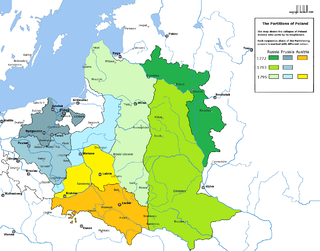
The Third Partition of Poland (1795) was the last in a series of the Partitions of Poland–Lithuania and the land of the Polish–Lithuanian Commonwealth among Prussia, the Habsburg monarchy, and the Russian Empire which effectively ended Polish–Lithuanian national sovereignty until 1918. The partition was the result of the Kościuszko Uprising and was followed by a number of Polish–Lithuanian uprisings during the period.
The 1794 Greater Poland uprising was a military insurrection by Poles in Wielkopolska against Kingdom of Prussia which had taken possession of this territory after the 1793 Second Partition of the Polish–Lithuanian Commonwealth.

Marian Langiewicz, full name Marian Antoni Melchior Langiewicz, was one of the leaders of the Polish January Uprising against the Russian Empire in 1863.
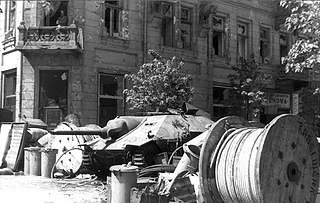
Barricade is any object or structure that creates a barrier or obstacle to control, block passage or force the flow of traffic in the desired direction. Adopted as a military term, a barricade denotes any improvised field fortification, such as on city streets during urban warfare.

Józef Grzegorz Chłopicki was a Polish general who was involved in fighting in Europe at the time of Napoleon and later.
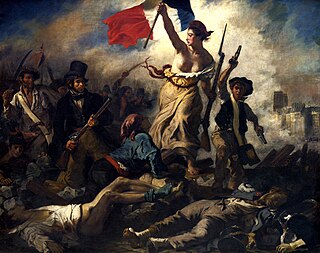
The Revolutions of 1830 were a revolutionary wave in Europe which took place in 1830. It included two "romantic nationalist" revolutions, the Belgian Revolution in the United Kingdom of the Netherlands and the July Revolution in France along with rebellions in Congress Poland, Italian states, Portugal and Switzerland. It was followed eighteen years later, by another and much stronger wave of revolutions known as the Revolutions of 1848.

Jan Zygmunt Skrzynecki was a Polish general, and commander-in-chief of the November Uprising (1830–1831).
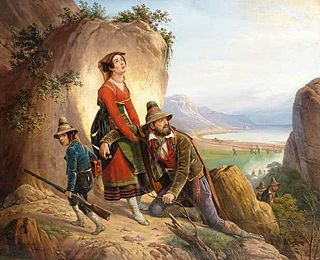
There were many resistance movements in partitioned Poland between 1795 and 1918. Although some of the szlachta was reconciled to the end of the Polish–Lithuanian Commonwealth in 1795, the possibility of Polish independence was kept alive by events within and without Poland throughout the 19th century. Poland's location on the North European Plain became especially significant in a period when its neighbours, the Kingdom of Prussia and Russia were intensely involved in European rivalries and alliances and modern nation states took form over the entire continent.

Staszic Palace is an edifice at ulica Nowy Świat 72, Warsaw, Poland. It is the seat of the Polish Academy of Sciences.
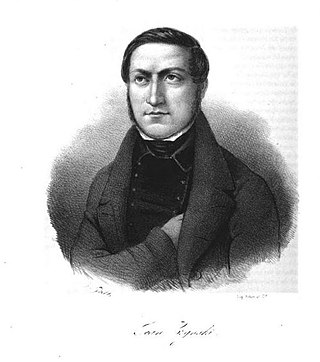
Jan Kazimierz Czyński (1801–1867) was a Polish independence activist, lawyer by education, writer and publicist, fighter for the emancipation of the Jews, trade supporter, utopian socialist, and radical democrat. He went into exile after the Russian government issued a bounty for his capture.

Józef Dwernicki was a General of Cavalry in the Polish Army, and a participant in the November Uprising (1830–1831).

Janko Popović, nicknamed Cincar Janko (Цинцар-Јанко), was a Serbian vojvoda, one of the most prominent leaders of the First Serbian Uprising.
![]() Media related to 1830 in Russia at Wikimedia Commons
Media related to 1830 in Russia at Wikimedia Commons